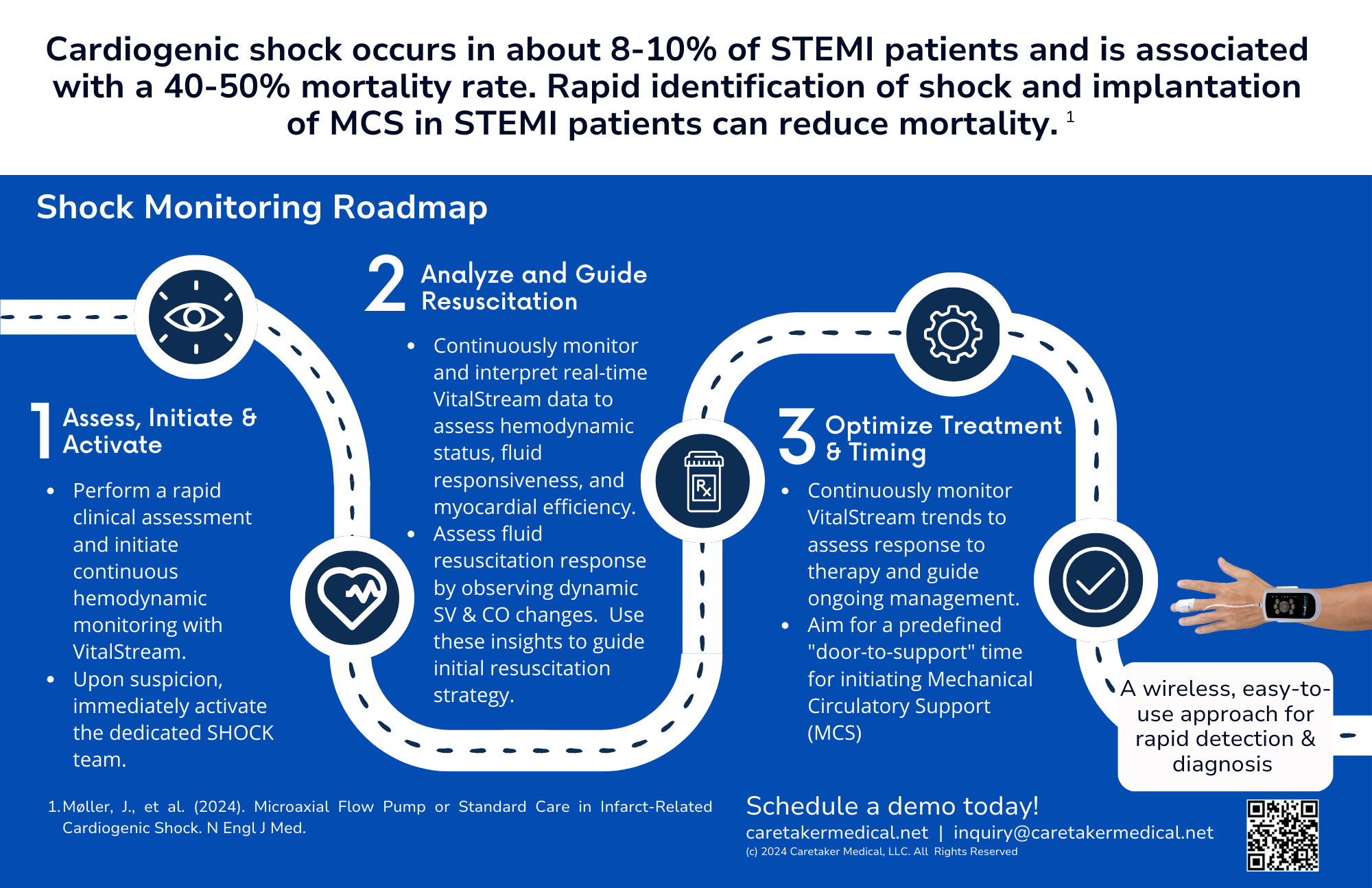
Caretaker Medical Unveils VitalStream Roadmap for Streamlined Cardiogenic Shock Monitoring at SCAI 2024
Charlottesville, VA – May 1, 2024 – Caretaker Medical, a leading innovator in advanced hemodynamic monitoring solutions, today announced the launch of its VitalStream® Cardiogenic Shock Continuous Monitoring Roadmap at the Society for Cardiovascular Angiography and Interventions (SCAI) 2024 meeting. This roadmap aligns with the National Cardiogenic Shock Initiative[i] criteria and timelines, empowering clinicians with a streamlined approach to early identification, and management of cardiogenic shock (CS).
Cardiogenic shock is a deadly condition where the heart abruptly weakens and cannot pump enough blood to meet the body’s needs. With a mortality rate as high as 50%[ii], early identification is critical for improving patient outcomes. Yet, timely diagnosis of CS remains a challenge.
“The VitalStream Roadmap empowers clinicians to combat this silent killer,” said Jeff Pompeo, CEO of Caretaker Medical. “By simplifying the monitoring process and providing real-time hemodynamic insights within 90 seconds of application, VitalStream can potentially save lives.”
VitalStream: Immediate and Continuous Monitoring for Faster, More Informed Decisions
The VitalStream Roadmap guides clinicians through a standardized process for CS identification using VitalStream, a continuous non-invasive monitoring system. VitalStream offers several key advantages over traditional methods:
- Rapid Setup: Streamlined application within 90 seconds minimizes time to critical data.
- Comprehensive Monitoring: Continuously monitors advanced hemodynamics including Blood Pressure (BP), Cardiac Output (CO), Cardiac Power Output (CPO), Heart Rate (HR), Stroke Volume (SV), and Systemic Vascular Resistance (SVR).
- Dynamic Therapy Response: Provides Delta Values (Delta CO, Delta CPO, Delta MAP, Delta SV, Delta SVR) to enable clinicians to assess a patient’s response to therapy in real-time, guiding ongoing management decisions.
Aligning with National Cardiogenic Shock Initiative
The VitalStream Roadmap is designed to support the goals of the National Cardiogenic Shock Initiative, a program focused on improving CS care through early identification, standardized treatment protocols, and quality improvement measures. By aligning with the Initiative’s criteria and timelines, VitalStream can help hospitals enhance their CS care pathways.
Showcasing VitalStream at SCAI 2024
Caretaker Medical will be showcasing the VitalStream Roadmap at SCAI 2024, booth #1037. Visitors can learn more about VitalStream’s capabilities and how it can improve their approach to CS monitoring.
About Caretaker Medical
Caretaker Medical is a medical technology company dedicated to developing innovative solutions that empower clinicians to deliver better patient care. The company’s flagship product, VitalStream, is a continuous non-invasive monitoring system that provides real-time hemodynamic data for improved clinical decision-making in critical care settings.
Sources:
More medical news and events

Caretaker Medical Receives Inaugural Healthcare Tech Innovation Award and $200,000 Grant from Medical Society of D.C.
WASHINGTON, DC, UNITED STATES, April 2, 2025 /EINPresswire.com/ -Caretaker Medical is honored to announce it has been awarded the Healthcare Technology Innovation Award, along with…

Caretaker Medical Awarded the Grand Prize in NIH RADx Tech for Maternal Health Challenge
Caretaker Medical, a digital health company focused on developing hemodynamic monitoring devices, today announced that it has been awarded the $525,000 grand prize in the…

VitalStream offers continuous hemodynamic monitoring solution amid IV fluid shortage
Philadelphia, PA – October 9, 2024 – Caretaker Medical, a pioneer in advanced hemodynamic monitoring technology, is highlighting the critical role of its VitalStream solution…
